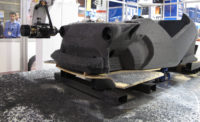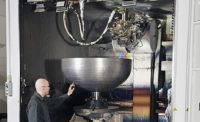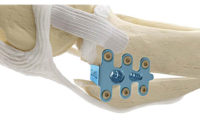Though simple in design, the oil pan is a vital part of a vehicle engine’s lubrication system. It is typically made of steel and contains a rubber gasket that prevents the oil from leaking. Over time, however, various things can put stress on the gasket and cause it to wear out, resulting in oil leakage.
Aware of this, the University of Victoria (UVic) Formula Motorsport team has been using 3D-printed oil pans for the last five years. The pans are made of CRP USA’s Windform Top-Line composite materials, which are carbon filled and 3D printed using the laser sintering process.
The Canada-based UVic team is a university club that designs and builds a new small, open-wheeled, formula-style car each year. The car then competes in Formula SAE, which is the world’s largest collegiate design competition.
On the UVic 2016 and 2017 race cars (known as UV16 and UV17), team engineers used the 3D-printed pans because they allowed the engine to be positioned significantly lower in the chassis. This design decreased the vehicle’s overall center of gravity and improved the car’s performance.
However, during a test on the team’s 2018 vehicle, its engine overheated, causing the oil temperature to increase beyond the limits of the designed pan. Post-race inspection showed that the baffle walls of the pan were significantly warped and one of the sections of the mating flange had been pulled into the pan, creating a significant leak.
To prevent the warping problem in the 2019 model, engineers made two important changes. One was to replace Windform XT 2.0 material with Windform SP, due to its higher melting point.
The other was to only have one central baffle wall located around the oil pickup and add a large supporting ridge to the top of the wall. This design change increased the available space for an aluminum pressure mating flange, resulting in a more-robust oil pan.
Another 3D-printed component in the UVic’s race car is the intake manifold. During races, the team is required to run a 20-millimeter restrictor as a bottleneck in the manifold’s inlet. The restrictor limits engine power for the safety of drivers and on-track personnel.
To optimize manifold and engine performance in light of this design requirement, team engineers use a computer simulation program to determine the ideal manifold dimensions. They then 3D print the part in the same manner as the oil pan.
According to Stephen Bradley, senior designer and UV19 project manager, 3D printing offers more flexibility than conventional joining methods such as welding and machining. The technology allows for a compact and complex runner geometry in the manifold, while keeping it rigid yet lightweight, with walls only 2.5 to 3 millimeters thick. Other notable features include equally centered runner bellmouths and seamlessly integrated injector seats.
UVic has fielded a car in Formula SAE races annually since 2013. Although its UV20 model had yet to be unveiled at press time, the team says it will feature a 4130 Chromoly steel space frame, and several aerodynamic components made of carbon fiber: a four-piece body, a three-element curved front wing, a five-element rear wing and three-element side wings.
For more information on composite materials for 3D printing, call 704-660-0258 or visit www.windform.com.





